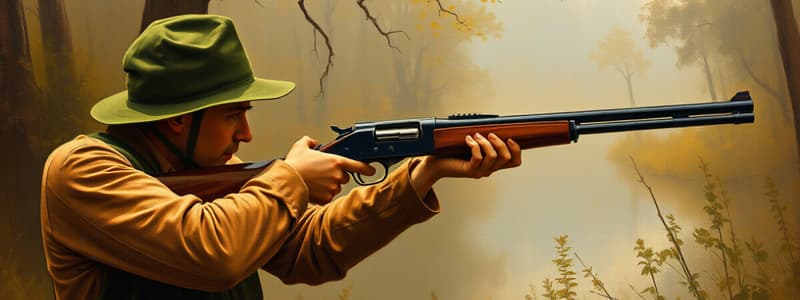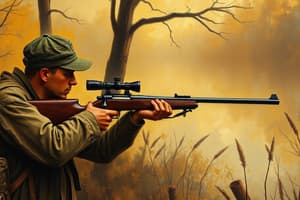Podcast
Questions and Answers
What are the 4 primary rules of firearm safety?
What are the 4 primary rules of firearm safety?
Which of the following is included in additional rules of firearm safety? (Select all that apply)
Which of the following is included in additional rules of firearm safety? (Select all that apply)
When did the first mandated hunter safety course begin?
When did the first mandated hunter safety course begin?
1949
What does IHEA stand for?
What does IHEA stand for?
Signup and view all the answers
What is knowledge in the context of hunter safety?
What is knowledge in the context of hunter safety?
Signup and view all the answers
How are safety skills gained?
How are safety skills gained?
Signup and view all the answers
What does involvement mean in this context?
What does involvement mean in this context?
Signup and view all the answers
What does the U.S. Fish and Wildlife Service provide?
What does the U.S. Fish and Wildlife Service provide?
Signup and view all the answers
What role do state wildlife agencies play?
What role do state wildlife agencies play?
Signup and view all the answers
When was the Pittman-Robertson Act approved?
When was the Pittman-Robertson Act approved?
Signup and view all the answers
Where do the funds for the Pittman-Robertson Act come from?
Where do the funds for the Pittman-Robertson Act come from?
Signup and view all the answers
Study Notes
Primary Rules of Firearm Safety
- Keep the muzzle pointed in a safe direction at all times.
- Treat every firearm as if it's loaded, regardless of belief.
- Confirm the target and what lies beyond it; never shoot at an animal on a skyline.
- Maintain your finger outside the trigger guard until ready to shoot.
Additional Rules of Firearm Safety
- Always check the barrel and ammunition before use.
- Only aim a firearm at objects you intend to shoot.
- Avoid running, jumping, or climbing with a loaded firearm.
- Unload firearms before navigating fences, trees, or ditches.
- Always pull firearms toward you by the butt, not the muzzle.
- Secure firearms safely during storage.
- Never consume alcohol before or while handling firearms.
Milestones in Hunter Safety
- First mandated hunter safety course launched in New York in 1949 to decrease hunting incidents.
International Hunter Education Association
- Known as IHEA, an organization focused on hunter education.
Knowledge in Firearm Safety
- Understanding safe gun handling basics is crucial before learning to shoot.
- Familiarity with firearm operation is necessary for safe management.
Developing Safety Skills
- Hands-on training and practice are essential for acquiring safety skills.
- Learning from experienced hunters enhances skill development.
Importance of Involvement in Hunting
- Responsible sportsmanship includes engaging in preserving the respect for hunting.
- Involvement can entail teaching others, collaborating with landowners, and working with game wardens.
- Joining conservation organizations is key for habitat preservation and wildlife management.
U.S. Fish and Wildlife Service Role
- Provides federal aid to state wildlife agencies for various hunting-related initiatives.
- The Federal Aid in Wildlife Restoration, established in 1937 by the Pittman-Robertson Act, supports hunter education and habitat improvement.
State Wildlife Agencies
- They sponsor hunter education programs throughout states and provinces.
Pittman-Robertson Act Overview
- Approved by Congress in 1937, this Act funds wildlife habitat management and research.
- It was amended in 1970 to also finance hunter education and public target ranges.
Funding from Pittman-Robertson Act
- Funded by an 11% federal excise tax on sporting goods and a 10% tax on handguns.
- Half the excise tax collected on handguns and archery equipment is allocated for hunter education and target ranges.
- Funds are collected from manufacturers and allocated annually by the Department of the Interior to states and territories.
Studying That Suits You
Use AI to generate personalized quizzes and flashcards to suit your learning preferences.
Description
Test your knowledge on the primary rules of firearm safety and milestones in hunter education. Explore key principles to ensure safe handling and storage of firearms, as well as the history of hunter safety courses. This quiz is essential for anyone interested in responsible hunting and firearm use.




